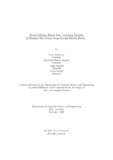Demystifying black-box learning models of rumor detection from social media posts
Abstract
Social media and its users are vulnerable to the spread of rumors, therefore, protect ing users from these rumors spread is extremely important. This research proposes a
novel approach for rumor detection in social media that consists of multiple robust
models: Support Vector Machine, XGBoost Classifier, Random Forest Classifier,
Extra Tree Classifier, and Decision Tree Classifier. To evaluate more, we com bine these five different machine learning models to build our own hybrid model.
Then, we apply two deep learning models- Long-Short Term Memory (LSTM) and
Bidirectional Encoder Representations from Transformers (BERT) and both show
promising results with high accuracy. For evaluations, we are using two datasets COVID19 Fake News Dataset and Twitter15 and Twitter16- two publicly available
datasets concatenated. The datasets contain posts from both Facebook and Twit ter. We extract the textual part of source posts in vector representations and fit
them into the models for predicting results and we evaluate the results. These arti ficial intelligence algorithms are often referred to as “Black-box” where data goes in
the box and predictions come out of the box but what is happening inside the box
frequently remains cloudy. Although there have been many inspired works for fake
news detection, still the number of works regarding rumor detection lags behind and
the models used in the existing works do not explain their decision-making process.
But with explainable AI, the opaque process happening inside the black box can be
explained. We use LIME to explain our models’ predictions. We take models with
higher accuracy and illustrate which feature of the data contributes the most for a
post to be predicted as a rumor or a non-rumor by the models, thus, demystifying
the black box learning models. Our hybrid model achieves an accuracy of 93.22%
and 82.49%, while LSTM provides 99.81%, 98.41% and BERT provides 99.62%,
94.80% accuracy on the COVID-19, Twitter15 and Twitter16 datasets respectively.

